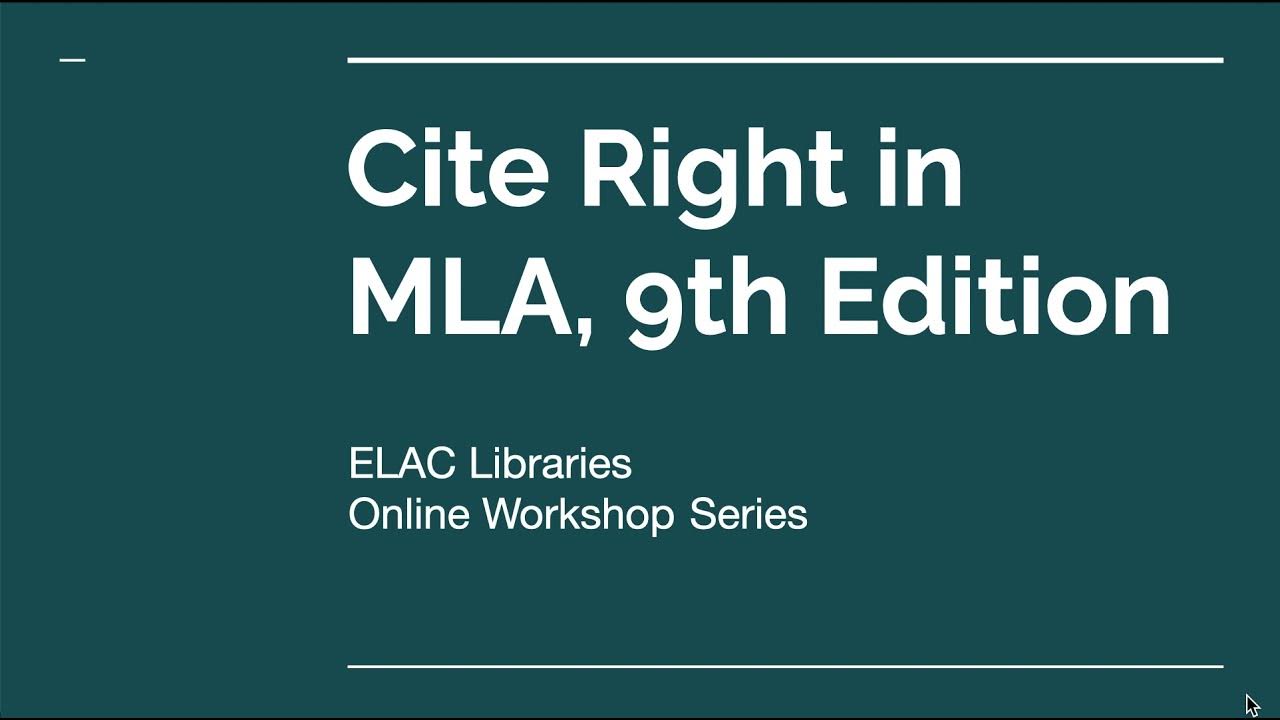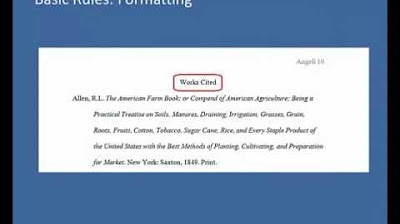MLA Works Cited and In text Citations tutorial
Summary
TLDRProfessor Morgan's video offers a detailed guide on MLA formatting, emphasizing the correct use of 'Works Cited' and in-text citations. It clarifies that 'Works Cited' should be alphabetized without bold or underline, and must include the required number of sources. The video also explains the proper placement of the 'Works Cited' page and the necessity of matching in-text citations with listed sources. Examples of common MLA mistakes are provided for educational purposes, aiming to help students avoid them.
Takeaways
- 📚 MLA citations use a 'Works Cited' page, not 'References', and it should not be in bold or underlined.
- 🔠 All entries on the Works Cited page should be in alphabetical order and use a hanging indent format.
- 📄 The Works Cited page does not count towards the required page count of your paper and starts on a new page.
- 🔗 Any source cited in the text must also appear on the Works Cited page, and vice versa.
- ✍️ In-text citations can be done in two ways: by introducing the source within the text (narrative citation) or by placing the citation at the end in parentheses (parenthetical citation).
- 📝 If quoting directly, the period comes after the parenthetical citation, not before.
- 🖥️ If a source doesn't have a page number (like online sources), you can omit the page number from the in-text citation.
- ❗ In-text citations are necessary for both direct quotes and paraphrased information that isn't common knowledge.
- ⚠️ Avoid using first-person narration or personal opinions in academic writing, as it weakens the argument and lacks proof.
- 🚫 Do not introduce new information in the conclusion, and avoid ending with phrases like 'That's just my opinion'; instead, reinforce your argument with key points discussed in the paper.
Q & A
What is the correct term for the list of sources in MLA formatting?
-The correct term for the list of sources in MLA formatting is 'Works Cited'. It is not 'References' and it should not be in bold or underlined.
How should the 'Works Cited' page be formatted according to the script?
-The 'Works Cited' page should be in alphabetical order and use a hanging indent. It should start on its own page and not count towards the total page number of the paper.
What is the minimum number of outside sources required if specified by an instructor?
-If an instructor specifies a minimum number of outside sources, the 'Works Cited' page should list at least that number of sources.
How does the script suggest ensuring that the 'Works Cited' page starts on its own page?
-The script suggests using a trick shown in other videos by Professor Morgan to ensure the 'Works Cited' page always starts on its own page.
What is the relationship between in-text citations and the 'Works Cited' page in MLA formatting?
-Every in-text citation must correspond to an entry on the 'Works Cited' page, and vice versa. They are connected and must be consistent.
How should a direct quote be cited within the text in MLA format?
-A direct quote should be introduced with the author's name and followed by the quote in quotation marks. The page number where the quote is found should be included in parentheses after the quote, with the period coming after the closing parenthesis.
What should be done if a source does not have a page number?
-If a source does not have a page number, such as an online source, the page number is omitted from the in-text citation.
How does the script describe the two different ways to do in-text citations in MLA?
-The script describes two ways to do in-text citations: one where the author's name is introduced before the quote, and another where the author's name is given in parentheses after the quote.
What is the significance of the period placement in MLA in-text citations?
-The period in MLA in-text citations should come after the closing parenthesis of the citation, not after the quote itself or before the parenthesis.
What mistake does the script highlight about using first-person in research papers?
-Using first-person and personal experiences weakens the strength of a research paper and is not considered proof. It is advised to avoid first-person narratives in research papers.
How should conclusions be written in MLA formatted papers according to the script?
-Conclusions should summarize the main points made in the paper without introducing new information or reverting to first-person narratives. They should not undermine the points made in the paper.
Outlines

Esta sección está disponible solo para usuarios con suscripción. Por favor, mejora tu plan para acceder a esta parte.
Mejorar ahoraMindmap

Esta sección está disponible solo para usuarios con suscripción. Por favor, mejora tu plan para acceder a esta parte.
Mejorar ahoraKeywords

Esta sección está disponible solo para usuarios con suscripción. Por favor, mejora tu plan para acceder a esta parte.
Mejorar ahoraHighlights

Esta sección está disponible solo para usuarios con suscripción. Por favor, mejora tu plan para acceder a esta parte.
Mejorar ahoraTranscripts

Esta sección está disponible solo para usuarios con suscripción. Por favor, mejora tu plan para acceder a esta parte.
Mejorar ahora5.0 / 5 (0 votes)






